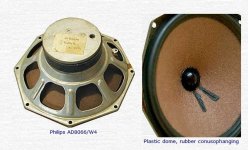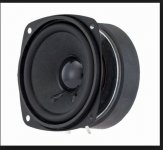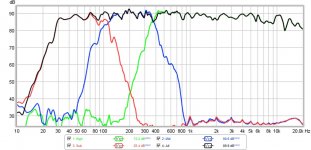So basically the Vifa isn't performing as it should in the highest frequencies...
Here are some examples of the Dunlavy speakers compared to other speakers:

Obviously the Dunlavy is the last entry.
I was wondering why that first spike was downwards on Halairs measurements...
Here are some examples of the Dunlavy speakers compared to other speakers:

Obviously the Dunlavy is the last entry.
I was wondering why that first spike was downwards on Halairs measurements...
What driver are you using in this script? Is this a 2-way?
I did use your script and old 1976 phillips drivers and a visaton FRS8M.
change some things afcourselike port rear box etc.
I did post it earlyer with Xmax.
regards
kees
Attachments
Last edited:
To be fair, here's a real measurement of the Dunlavy SC-IV/A
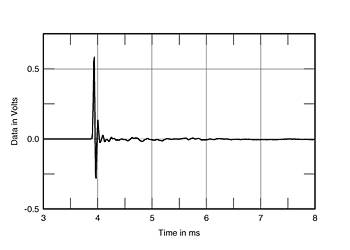
John Dunlavy was quite obsessive about impulse and step response. The key to a good speaker as he saw it. That's why I'm trying to figure out what is happening in those high frequencies. So basically you got the extra spike from EQ-ing the response.

stereophile said:The step response (fig.8) indicates excellent time coherence, the acoustic outputs from all five drive-units arriving at the microphone at the same time. The slight overshoot correlates with the excess of HF energy apparent in the frequency response on this axis at this mike distance, and again the early reflections can be seen.
John Dunlavy was quite obsessive about impulse and step response. The key to a good speaker as he saw it. That's why I'm trying to figure out what is happening in those high frequencies. So basically you got the extra spike from EQ-ing the response.
Wesayso,
I think much of the ringing artifacts you see in this example of the Vifa in the tractrix stems from the fact that the Vifa is underdamped (high Qts) and not ideal for horn loading where there is a lot of chamber pressure that feeds back onto the driver as it is moving around. The horn then amplifies these little pressure fluctuations resulting from the acoustic impedance variations onto the driver. If you run the Vifa in the Nautaloss, for example, where the acoustic impedance feedback is very little (open face on front and tapered sealed spiral TL in back), the Vifa can do a much better job with the impulse response. A lot of it can also be attributed to the digital domain processing that imparts the extra overshoot. See for example this IR result for the Vifa in the Nautaloss without miniDSP (just going straight through to a class D amp) and with a miniDSP in between but set to be "neutral" no gain or EQ applied but only with a 50Hz HPF.
No mini-DSP:
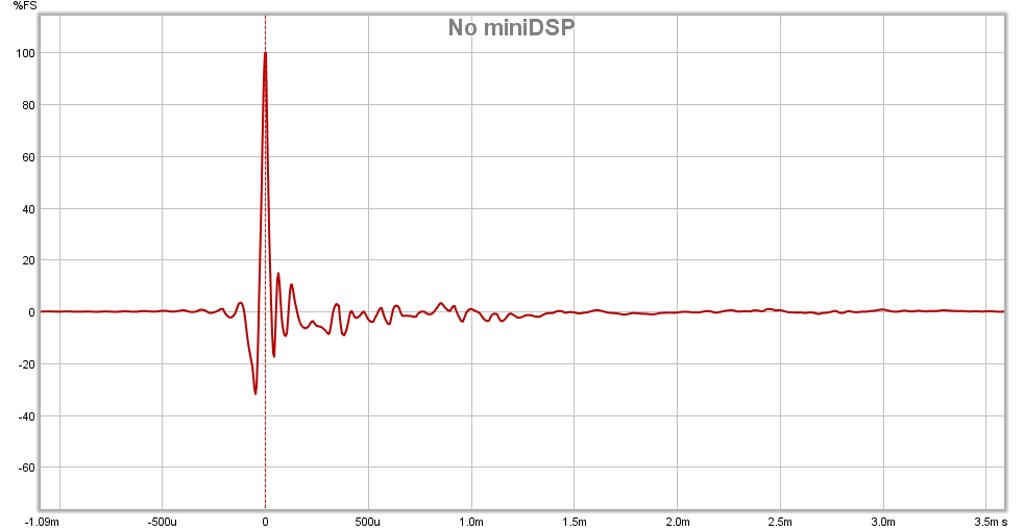
With mini-DSP (and 50Hz HPF):
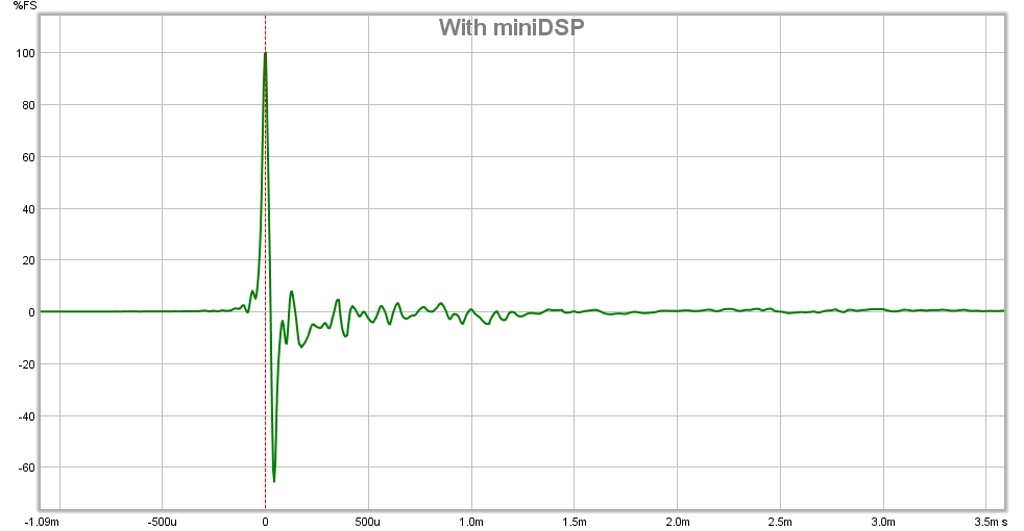
You can see that the Vifa actually does a respectable job, and certainly without DSP in between, you will get a technically cleaner IR. However, to my ears, I cannot detect the presence of the overshoot imparted by the DSP. Maybe more trained or sensitive ears can? I think the overshoot is the artifact of a HPF function in the DSP. However, the DSP improves the phase linearity over analog! That should be perceptible as enhanced spatial imaging.
In any case, look at the Vifa in the Nautaloss and compare that to the much more expensive Dunlavy - not sure I could hear the difference in a cymbal or high-hat strike with those two IR curves.
More details on my study of the impact of miniDSP on sonic performance can be found in the Nautaloss thread here:
http://www.diyaudio.com/forums/full-range/247598-nautaloss-ref-monitor-26.html#post3808837
Edit: Just saw your post above - looks very similar now to the miniDSP and TC9FD!

I think much of the ringing artifacts you see in this example of the Vifa in the tractrix stems from the fact that the Vifa is underdamped (high Qts) and not ideal for horn loading where there is a lot of chamber pressure that feeds back onto the driver as it is moving around. The horn then amplifies these little pressure fluctuations resulting from the acoustic impedance variations onto the driver. If you run the Vifa in the Nautaloss, for example, where the acoustic impedance feedback is very little (open face on front and tapered sealed spiral TL in back), the Vifa can do a much better job with the impulse response. A lot of it can also be attributed to the digital domain processing that imparts the extra overshoot. See for example this IR result for the Vifa in the Nautaloss without miniDSP (just going straight through to a class D amp) and with a miniDSP in between but set to be "neutral" no gain or EQ applied but only with a 50Hz HPF.
No mini-DSP:

With mini-DSP (and 50Hz HPF):

You can see that the Vifa actually does a respectable job, and certainly without DSP in between, you will get a technically cleaner IR. However, to my ears, I cannot detect the presence of the overshoot imparted by the DSP. Maybe more trained or sensitive ears can? I think the overshoot is the artifact of a HPF function in the DSP. However, the DSP improves the phase linearity over analog! That should be perceptible as enhanced spatial imaging.
In any case, look at the Vifa in the Nautaloss and compare that to the much more expensive Dunlavy - not sure I could hear the difference in a cymbal or high-hat strike with those two IR curves.
More details on my study of the impact of miniDSP on sonic performance can be found in the Nautaloss thread here:
http://www.diyaudio.com/forums/full-range/247598-nautaloss-ref-monitor-26.html#post3808837
Edit: Just saw your post above - looks very similar now to the miniDSP and TC9FD!

Last edited:
Here's what Dunlavy had to say about impulse point 2) in this document:
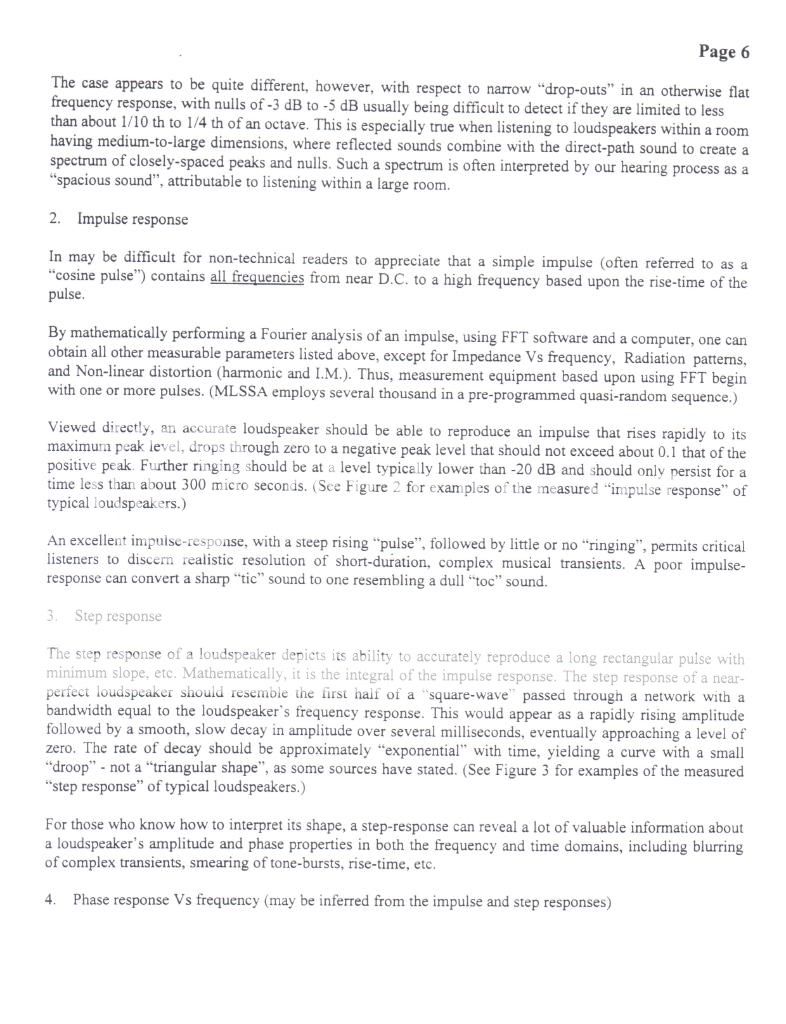
The difference of coarse being Dunlavy used a tweeter, two mids and 2 woofers against the single Vifa in your Nautaloss.
Just trying to learn/figure out the impulse differences and step as well by looking at Halairs measurements (which sure look promising to me)

The difference of coarse being Dunlavy used a tweeter, two mids and 2 woofers against the single Vifa in your Nautaloss.
Just trying to learn/figure out the impulse differences and step as well by looking at Halairs measurements (which sure look promising to me)
Impuls behavior is independent of weight cone, speaker enclosure, motor. and has a very strict behavior on each other, this make it very difficult to get it right in nature and speakers wil always have compromissing things, for as impuls, closed enclosures has the most tight impuls behavior if I have to believe that people but active shelf filters to resceue bas will distroy this again, horns are in my opinion also not ideal, but because of the very small conus movements impuls can be very good in mid high.
In my eyes as amp designer a super emittorfollower who make a very low impedance amplifier with high dampings factor and big motor give nice results also, horns do this from itselfs by load the speaker cone and do wel with tubes.
luckely we have sims, these days and can make nice stuff.
the speaker in the horn on this threat has a very big motor but also heavy cone, I am suprised it go to 15 Khz with it, it makes also that it is ideal for horns, qts is somewhat high but this is because of that heavy cone.
regards
kees
In my eyes as amp designer a super emittorfollower who make a very low impedance amplifier with high dampings factor and big motor give nice results also, horns do this from itselfs by load the speaker cone and do wel with tubes.
luckely we have sims, these days and can make nice stuff.
the speaker in the horn on this threat has a very big motor but also heavy cone, I am suprised it go to 15 Khz with it, it makes also that it is ideal for horns, qts is somewhat high but this is because of that heavy cone.
regards
kees
Last edited:
Kees,
You are talking about the 5MR450NDY right? That is not used in the 0.7x tractrix in this thread just to be clear. It does indeed work well in a horn as that heavy cone is stiff and more pistonic in behavior. It goes to 15kHz out of brute motor strength and some breakup modes. However, if one is a full range driver listener, the breakup is not that objectionable.
In ordered some Faital Pro 3FE25 and 3FE22 that should be here in a few days. We will see if they improve the smoothness of the frequency response in this tractrix. More powerful motor, stiffer cone, stiffer suspension.
Your sims with the FRS8 look very promising. You really should make this horn.
You are talking about the 5MR450NDY right? That is not used in the 0.7x tractrix in this thread just to be clear. It does indeed work well in a horn as that heavy cone is stiff and more pistonic in behavior. It goes to 15kHz out of brute motor strength and some breakup modes. However, if one is a full range driver listener, the breakup is not that objectionable.
In ordered some Faital Pro 3FE25 and 3FE22 that should be here in a few days. We will see if they improve the smoothness of the frequency response in this tractrix. More powerful motor, stiffer cone, stiffer suspension.
Your sims with the FRS8 look very promising. You really should make this horn.
Last edited:
Am i wrong about Danley Synergy have phase turn magic as in first plot.
Here example sealed box BW/Qtc0,707/Fsc71,48, and this represents single pointing full range driver, lets pretend it's real world linear from box HP and up.
180º phase turn (Purple) from DC-HF because of box HP filter and this makes the un-linear error in LF group delay (blue). Could i believe listening headphones have same minimum phase turn as seen here and is possibility some sound very good just without live room modes added but a form of CD.
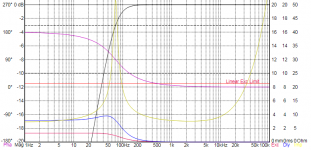
I percieved Danley's Synergy have nearly same plot (magic) as above acting as a single pointing driver even it's 3 way passive and at same have acoustic CD feature.
Now fullrange synergy, here last plot:
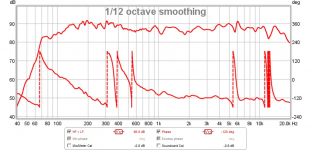
HP filter 6,5" and XO to Vifa gives 720º phase turn in relative narrow band and doesn't this give too crude group delay and spoils device to be perceived as real single pointing driver though the CD feature is in place. Don't know if clever passive SERIEL XO or DSP linear XO can be used here.
Here example sealed box BW/Qtc0,707/Fsc71,48, and this represents single pointing full range driver, lets pretend it's real world linear from box HP and up.
180º phase turn (Purple) from DC-HF because of box HP filter and this makes the un-linear error in LF group delay (blue). Could i believe listening headphones have same minimum phase turn as seen here and is possibility some sound very good just without live room modes added but a form of CD.

I percieved Danley's Synergy have nearly same plot (magic) as above acting as a single pointing driver even it's 3 way passive and at same have acoustic CD feature.
Now fullrange synergy, here last plot:

HP filter 6,5" and XO to Vifa gives 720º phase turn in relative narrow band and doesn't this give too crude group delay and spoils device to be perceived as real single pointing driver though the CD feature is in place. Don't know if clever passive SERIEL XO or DSP linear XO can be used here.
Last edited:
I haven't had chance to time align the woofer and fullrange yet (time consuming process). Probably cause of 720 deg wrap but as I understand it, psychoacoustic effects below 500hz don't have huge sensitivity to phase linearity for spatial imaging effects. In other words, I think most of the magic is there. Am I incorrect in this assumption of the importance of the critical 500Hz to 5khz range for phase linearity to psychoacoustics?
Mistake by me i really thought that clever scripts you use could calculate those four injection points in a acoustic magic way where they blend with HF driver in both FR and phase domain combined a certain order minimum phase XO filter, hereby acting as one sealed driver.
You correct description psychoacoustic effects below 500hz, by this i now see the strategic picked XO that i had not noticed, thanks answer.
You correct description psychoacoustic effects below 500hz, by this i now see the strategic picked XO that i had not noticed, thanks answer.
3-way Synergy with sub
I got the 4 way XO plugin for miniDSP and tested it out to add a subwoofer. Kind of cool what you can so with a miniDSP board and two class D amps. Lets you make a 4 way active speaker. You can see that I need to work on time alignment at mid to high XO. I am using 48dB slope here.
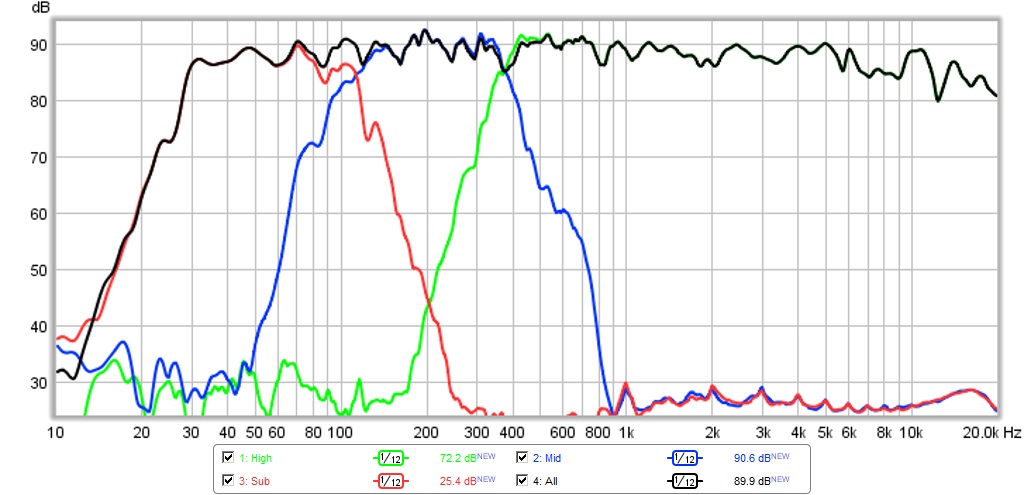
I got the 4 way XO plugin for miniDSP and tested it out to add a subwoofer. Kind of cool what you can so with a miniDSP board and two class D amps. Lets you make a 4 way active speaker. You can see that I need to work on time alignment at mid to high XO. I am using 48dB slope here.

Attachments
To measure phase in room, you should adjust the time window very short (ideally so short that it filters out the floor bounce, which is usually he first early reflection) or measure right at the mouth, otherwise reflections are gonna affect the measurement.
X, did you try the time widowing in REW before when we spoke of it?
Cone resonances can cause those "wraps"/phase distortion, for example dust cap can (and usually will) resonate/radiate "as separate radiator" and the acoustic crossover between the cone and dust cap distorts the phase. This is usually more severe with whizzer designs. It does not really matter whether the xo is electrical, acoustical or mechanical.
X, did you try the time widowing in REW before when we spoke of it?
Cone resonances can cause those "wraps"/phase distortion, for example dust cap can (and usually will) resonate/radiate "as separate radiator" and the acoustic crossover between the cone and dust cap distorts the phase. This is usually more severe with whizzer designs. It does not really matter whether the xo is electrical, acoustical or mechanical.
Last edited:
A good example of that phase behavior is the measurements from Halair. If I window to 4 ms to leave out most reflections the phase plot (unwrapped) looks like this:

Above 12K is probably the dust cap doing it's thing? But the array seems to measure as one speaker as far as phase goes. about the same as a full range speaker with a 180 degree turn from low to high. This is a no EQ measurement. Hope Halair doesn't mind me posting this .
.

Above 12K is probably the dust cap doing it's thing? But the array seems to measure as one speaker as far as phase goes. about the same as a full range speaker with a 180 degree turn from low to high. This is a no EQ measurement. Hope Halair doesn't mind me posting this
X, did you try the time widowing in REW before when we spoke of it?
Legis,
Can you walk me thru the menu and selections to do this? There are a lot of time window options - not sure if I looking at right menu or pop up.
Thanks
A good example of that phase behavior is the measurements from Halair. If I window to 4 ms to leave out most reflections the phase plot (unwrapped) looks like this:

Above 12K is probably the dust cap doing it's thing? But the array seems to measure as one speaker as far as phase goes. about the same as a full range speaker with a 180 degree turn from low to high. This is a no EQ measurement. Hope Halair doesn't mind me posting this.
Is that "real phase" or minimum phase and how was that measured? From listening position the phase usually goes totally haywire.
Could you post a picture with phase, (generated) minimum phase and excess phase plotted?
An example (JBL 2446J comp driver measured nearfield, without horn)
An externally hosted image should be here but it was not working when we last tested it.
Way cool. I need to step my game up.
Thanks! Glad to see you don't think it is a waste of time to use a fullrange in a Synergy anymore. Sure we have cone breakup, but what we get back in phase coherence from 600hz to 5khz without that tricky XO near 1khz to 1.5kHz seems worth it.
Could you post a picture with phase, (generated) minimum phase and excess phase plotted?
Wesayso,
Do you want just the Vifa measured nearfield or also with mid woofers on? I still need to dial in time alignment in that case.
- Home
- Loudspeakers
- Multi-Way
- Presenting the Trynergy - a full range tractrix synergy.
